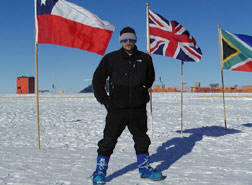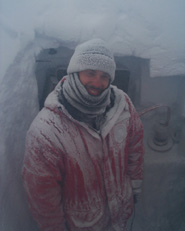
- 1999
- 2000
- 2001
- 2002
- 2003
- 2006
- 2007
View a map of the team's route
 Dan Dixon
Dan Dixon
Science Driller
University of Maine
Orono, Maine
Hello, my name is Dan Dixon. I was born and raised in London, England. I received my BSc in Geology and Oceanography from the School of Ocean and
Earth Science at the University of Southampton. My undergraduate thesis was based on a Training Through Research (TTR) cruise in the Atlantic Ocean.
The UNESCO-IOC Floating University ran the TTR cruise and we studied the Southwest Iberian continental margin and mud volcanoes in the Gulf of Cadiz.
During our cruise we imaged many new seafloor features in high resolution using sidescan sonar, we also "ground-truthed" them using a 4m-long
gravity corer and a 2-ton hydraulic grab.
During my final exams in my last year at Southampton University I received an email from one of my lecturers, Dr. Eelco Rohling, detailing the opportunity
to become a research assistant for Prof. Paul Mayewski in the U.S.A. The position offered the added benefits of gaining a Masters Degree and exploring
Antarctica. I was very excited and jumped at the chance to study abroad. I filled out all the appropriate forms, applied for my visa, and in October
of 2000 I arrived in Maine.
Since arriving in Maine I have been involved in lots of exciting projects. The most exciting of these projects are the U.S.ITASE traverses in West Antarctica. I spent two field seasons Antarctica from 2001-2003 and helped to drill many hundreds of meters of ice core during that time. I hope to spend another three successful months there this season and drill seven more cores
 My Masters thesis is based on the ~200 year, sub-annually
resolved, multivariate ice core & snowpit chemistry timeseries from the U.S.ITASE cores. The timeseries are generated using a new University of
Maine continuous melter system and an Ion Chromatograph (IC) machine. The timeseries data consist of dissolved major ion concentrations at sub-annual
resolution for the length of each core; the ions are Na (sodium), NH4 (ammonium), K (potassium), Mg (magnesium), Ca (calcium), Cl (chloride), NO3 (nitrate),
SO4 (sulfate), and MS (methylsulfonate). These ions, either individually or in combinations, indicate many different processes occurring in, around,
or over Antarctica. By looking at these ion concentrations down ice cores it is possible to obtain accurately dated, sub-annual records of Antarctic
meteorological and glaciochemical processes hundreds, or sometimes thousands of years into the past.
My Masters thesis is based on the ~200 year, sub-annually
resolved, multivariate ice core & snowpit chemistry timeseries from the U.S.ITASE cores. The timeseries are generated using a new University of
Maine continuous melter system and an Ion Chromatograph (IC) machine. The timeseries data consist of dissolved major ion concentrations at sub-annual
resolution for the length of each core; the ions are Na (sodium), NH4 (ammonium), K (potassium), Mg (magnesium), Ca (calcium), Cl (chloride), NO3 (nitrate),
SO4 (sulfate), and MS (methylsulfonate). These ions, either individually or in combinations, indicate many different processes occurring in, around,
or over Antarctica. By looking at these ion concentrations down ice cores it is possible to obtain accurately dated, sub-annual records of Antarctic
meteorological and glaciochemical processes hundreds, or sometimes thousands of years into the past.
 So far, my colleagues and I at the University
of Maine have made many exciting discoveries about U.S.ITASE ice cores; the Tambora volcanic event of 1815 shows up clearly as a large peak in the
sulfate timeseries. This peak occurs in every U.S.ITASE ice core processed thus far. The El Niño Southern Oscillation is truly a 'global' phenomenon,
its influence is detectable as a pronounced periodicity in many U.S.ITASE ice cores. Theatmospheric nuclear testing during the 1950's and 1960's has
produced slightly radioactive "bomb-layers" which can be detected in all the ice cores. We have also discovered that there is no significant
anthropogenically-induced rise in recent concentrations of sulfate in West Antarctic ice cores. This is a stark contrast to Northern Hemisphere ice
cores that exhibit huge sulfate concentration increases over recent decades.
So far, my colleagues and I at the University
of Maine have made many exciting discoveries about U.S.ITASE ice cores; the Tambora volcanic event of 1815 shows up clearly as a large peak in the
sulfate timeseries. This peak occurs in every U.S.ITASE ice core processed thus far. The El Niño Southern Oscillation is truly a 'global' phenomenon,
its influence is detectable as a pronounced periodicity in many U.S.ITASE ice cores. Theatmospheric nuclear testing during the 1950's and 1960's has
produced slightly radioactive "bomb-layers" which can be detected in all the ice cores. We have also discovered that there is no significant
anthropogenically-induced rise in recent concentrations of sulfate in West Antarctic ice cores. This is a stark contrast to Northern Hemisphere ice
cores that exhibit huge sulfate concentration increases over recent decades.